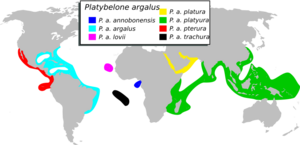Keeltail needlefish facts for kids
Quick facts for kids Keeltail needlefish |
|
|---|---|
 |
|
| Platybelone argalus | |
| Conservation status | |
| Scientific classification | |
| Subspecies | |
|
See text |
|
| Synonyms | |
|
The keeltail needlefish (Platybelone argalus), also known as the keeled needlefish, is a type of fish that lives in warm, tropical waters. It belongs to the needlefish family called Belonidae. A French scientist named Charles Alexandre Lesueur first described this fish in 1821.
Contents
What Does a Keeltail Needlefish Look Like?
Keeltail needlefish look a lot like the freshwater gars found in North America. Their most unique feature is the large, flat, keel-like parts on both sides of their tail. These keels help them swim.
They have fins on their back (dorsal fin) with 12 to 15 rays. Their fin on the underside (anal fin) has 17 to 20 rays. Keeltail needlefish also have gill-rakers, which are like combs that help them filter food from the water. The part of their body just before the tail, called the caudal peduncle, also has keels on its sides. A special line, called the lateral line, runs along their body below these keels. This line helps them sense movements in the water.
These fish can grow up to 50 centimeters (about 20 inches) long. An interesting fact about their mouth is that their top jaw is shorter than their bottom jaw.
Where Do Keeltail Needlefish Live?
Keeltail needlefish are found in many parts of the world's oceans. In the western Atlantic Ocean, you can find them from North Carolina all the way down to Brazil. This includes places like the Gulf of Mexico, the Bahamas, and the Caribbean Sea.
They also live in the Indian Ocean near East Africa. Their home continues into the Pacific Ocean, reaching as far as the Hawaiian Islands and north to the Ogasawara Islands. You can also find them around the Arabian Peninsula, in the Red Sea and Persian Gulf.
These fish usually live offshore, away from the coast, and are very common around islands. They often swim together in groups, called schools, in calm areas around reefs. They mostly eat smaller fish.
Reproduction and Life Cycle
Keeltail needlefish lay eggs. Their eggs have special tendril-like structures on their surface. These tendrils help the eggs attach to floating objects in the water, keeping them safe as they develop.
Types of Keeltail Needlefish (Subspecies)
Scientists recognize seven different types, or subspecies, of the keeltail needlefish:
- Platybelone argalus annobonensis (Annobon keeltail needlefish)
- P. a. argalus (keeltail needlefish)
- P. a. lovii
- P. a. platura
- P. a. platyura (keeled needlefish)
- P. a. pterura (Baja California keeltail needlefish)
- P. a. trachura
It's worth noting that some scientists believe that some of these subspecies, like P.a. lovii, P.a. platyura, and P.a. trachura, are actually separate species on their own.



